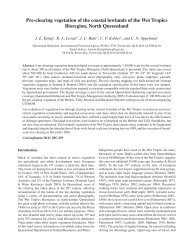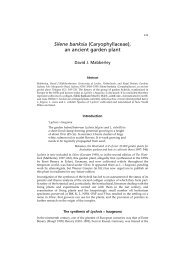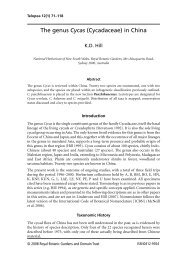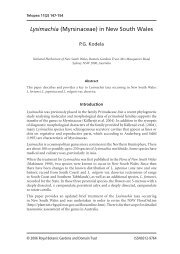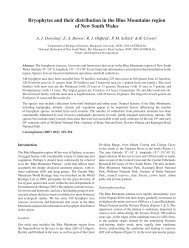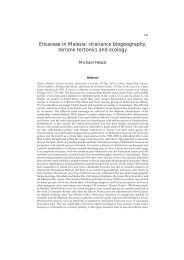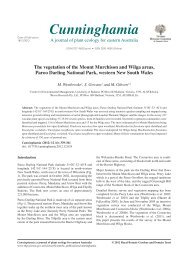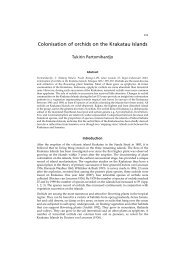Endosperm condition and the paradox of Ptychococcus paradoxus
Endosperm condition and the paradox of Ptychococcus paradoxus
Endosperm condition and the paradox of Ptychococcus paradoxus
Create successful ePaper yourself
Turn your PDF publications into a flip-book with our unique Google optimized e-Paper software.
<strong>Endosperm</strong> <strong>condition</strong> <strong>and</strong> <strong>the</strong> <strong>paradox</strong> <strong>of</strong><br />
<strong>Ptychococcus</strong> <strong>paradox</strong>us<br />
Scott Zona<br />
Abstract<br />
Zona, S. (Fairchild Tropical Garden, 11935 Old Cutler Road, Coral Gables, FL 33156-4242, USA. e-mail:<br />
szona@fairchildgarden.org). <strong>Endosperm</strong> <strong>condition</strong> <strong>and</strong> <strong>the</strong> <strong>paradox</strong> <strong>of</strong> <strong>Ptychococcus</strong> <strong>paradox</strong>us. Telopea<br />
10(1): 179–185. <strong>Endosperm</strong> <strong>condition</strong>, whe<strong>the</strong>r homogeneous or ruminate, is an easily-observed<br />
character that is widely used in species level taxonomy <strong>of</strong> palms, although it appears to be a poor<br />
indicator <strong>of</strong> relationships at higher levels. Palms are routinely described as having homogeneous<br />
or ruminate endosperms; however, all endosperm ruminations may not be homologous.<br />
My experience with <strong>the</strong> palm genus <strong>Ptychococcus</strong> (Arecaceae: Arecoideae) suggests that<br />
misinterpretations <strong>of</strong> endosperm variation have led to taxonomic confusion. I have examined<br />
herbarium specimens <strong>of</strong> lowl<strong>and</strong> <strong>Ptychococcus</strong> <strong>and</strong> conclude that variation in endosperm <strong>condition</strong><br />
is continuous, from completely homogeneous to slightly ruminate to deeply ruminate. In <strong>the</strong><br />
absence <strong>of</strong> contradictory evidence from o<strong>the</strong>r characters, I conclude that <strong>the</strong> various taxa defined<br />
solely by <strong>the</strong>ir endosperm <strong>condition</strong> cannot be maintained <strong>and</strong> that only one species <strong>of</strong><br />
<strong>Ptychococcus</strong>, P. <strong>paradox</strong>us, should be recognized from <strong>the</strong> lowl<strong>and</strong>s <strong>of</strong> New Guinea. The <strong>paradox</strong><br />
<strong>of</strong> P. <strong>paradox</strong>us lies in <strong>the</strong> variability <strong>of</strong> its endosperm, which has been confounding botanists for<br />
over a century.<br />
Introduction<br />
<strong>Endosperm</strong> <strong>condition</strong>, whe<strong>the</strong>r ruminate or homogeneous, has long been recognized as<br />
a useful <strong>and</strong> <strong>of</strong>ten diagnostic character state in angiosperms. A ruminate endosperm is<br />
characterized by in-growths or invaginations <strong>of</strong> <strong>the</strong> endosperm by <strong>the</strong> seed coat (Bayer<br />
& Appel 1996, Werker 1997). A homogeneous endosperm lacks such in-growths.<br />
Obvious examples <strong>of</strong> ruminate endosperms are found in <strong>the</strong> seeds <strong>of</strong> nutmeg, Myristica<br />
fragrans Houtt. (Myristicaceae), <strong>and</strong> betel nuts, Areca catechu L. (Arecaceae).<br />
A recent survey <strong>of</strong> Angiosperms by Bayer <strong>and</strong> Appel (1996) found 58 families in which<br />
<strong>the</strong> ruminate endosperm <strong>condition</strong> is known to occur, <strong>and</strong> van Balgooy (1997) listed<br />
those Malesian seed plants with <strong>the</strong> ruminate <strong>condition</strong> (although he also included<br />
exalbuminous taxa with convoluted embryos, which are usually termed ‘labyrinth<br />
seeds’). Prominent on both <strong>of</strong> those lists is <strong>the</strong> palm family (Arecaceae). Within <strong>the</strong><br />
palm family, 51 genera (out <strong>of</strong> nearly 200) have at least one species with ruminate<br />
endosperm, <strong>and</strong> 23 <strong>of</strong> <strong>the</strong>se genera occur in <strong>the</strong> Malesian region (Table 1).<br />
Ruminate endosperm morphology has been used successfully in <strong>the</strong> classification <strong>of</strong><br />
some groups, e.g. Annonaceae (van Setten & Koek-Noorman 1992), but <strong>the</strong><br />
morphology <strong>of</strong> endosperm ruminations in palms has not been carefully examined.<br />
Although <strong>the</strong> presence or absence <strong>of</strong> ruminate endosperm is much used at <strong>the</strong> species<br />
level in palms, it appears to be homoplasious when used for higher level classification.<br />
Ruminate endosperm occurs in four different subfamilies <strong>of</strong> palms <strong>and</strong> numerous<br />
tribes <strong>and</strong> subtribes (Table 1), an observation suggesting that it has evolved <strong>and</strong>/or<br />
been lost many times in <strong>the</strong> course <strong>of</strong> palm evolutionary history.<br />
179
180 Telopea 10(1): 2003<br />
Table 1. Occurrence <strong>of</strong> ruminate endosperm within <strong>the</strong> Arecaceae (Uhl & Dransfield 1987, with<br />
modifications from Dowe & Cabalion 1996, Barrow 1998, Uhl <strong>and</strong> Dransfield 1999 <strong>and</strong> Dransfield<br />
et al. 2000). Genera occurring in Malesia are marked with an asterisk (*).<br />
CORYPHOIDEAE<br />
Chamaerops<br />
Copernicia<br />
Chuniophoenix p.p.<br />
Kerriodoxa*<br />
Phoenix p.p.*<br />
Medemia<br />
Satranala<br />
CALAMOIDEAE<br />
Korthalsia p.p.*<br />
Daemonorops*<br />
Calamus p.p.*<br />
Raphia<br />
CEROXYLOIDEAE<br />
Synechanthus<br />
ARECOIDEAE<br />
Caryota p.p.*<br />
Wettinia p.p.<br />
Reinhardtia p.p.<br />
Dypsis p.p.<br />
Euterpe p.p.<br />
Prestoea p.p.<br />
Neonicholsonia<br />
Oenocarpus p.p.<br />
Archontophoenix<br />
Laccospadix<br />
Calyptrocalyx p.p.*<br />
Drymophloeus p.p.*<br />
Normanbya<br />
Adonidia*<br />
Ptychosperma p.p.*<br />
<strong>Ptychococcus</strong> p.p.*<br />
Loxococcus<br />
Lemurophoenix<br />
Siphokentia*<br />
Hydriastele p.p.*<br />
Gulubia p.p.*<br />
Nenga*<br />
Pinanga p.p.*<br />
Areca*<br />
Iguanura p.p.*<br />
Heterospa<strong>the</strong> p.p.*<br />
Rhopaloblaste*<br />
Dictyospermum<br />
Actinorhytis*<br />
Physokentia p.p.*<br />
Oncosperma*<br />
Verschaffeltia<br />
Roscheria<br />
Phoenicophorium<br />
Nephrospermum<br />
Beccariophoenix<br />
Syagrus p.p.<br />
Lytocaryum p.p.<br />
Poly<strong>and</strong>rococos<br />
Development <strong>of</strong> ruminations<br />
The ruminate endosperms <strong>of</strong> palms have been <strong>the</strong> subject <strong>of</strong> several anatomical<br />
studies, although <strong>the</strong> topic is not yet exhausted. Periasamy (1962) classified ruminate<br />
palm seeds as 1) <strong>the</strong> Annona type: possessing localized meristematic activity in a<br />
multi-layered seed coat that produces in-growths in <strong>the</strong> endosperm, or 2) <strong>the</strong> Myristica<br />
type, which is similar but <strong>the</strong> in-growths have vascular tissue or are subadjacent to<br />
vascular tissue. Examples <strong>of</strong> <strong>the</strong> Annona type include Caryota <strong>and</strong> Heterospa<strong>the</strong> (Werker<br />
1997); examples <strong>of</strong> <strong>the</strong> Myristica type include Adonidia <strong>and</strong> Bentinckia (Murray 1971,<br />
Padamanabham & Regupathy 1981). Examples <strong>of</strong> Periasamy’s o<strong>the</strong>r five types <strong>of</strong><br />
ruminate endosperm, which differ in <strong>the</strong> number <strong>of</strong> integument layers <strong>and</strong> layers <strong>of</strong><br />
<strong>the</strong> seed coat, have not been found in <strong>the</strong> Arecaceae.<br />
Werker (1997) noted additional variation in <strong>the</strong> development <strong>of</strong> palm seed<br />
ruminations. The endosperm <strong>of</strong> some palm seeds, at an early stage <strong>of</strong> development<br />
becomes quiescent while <strong>the</strong> seed coat <strong>and</strong> integuments develop irregularities. When<br />
at a later stage, <strong>the</strong> endosperm again commences growth, it fills in <strong>the</strong> around <strong>the</strong> seed<br />
coat. One might say that <strong>the</strong> seed coat leads, <strong>and</strong> <strong>the</strong> endosperm follows. In contrast,<br />
ruminations in o<strong>the</strong>r palms develop as a result <strong>of</strong> unequal <strong>and</strong> localized cell division<br />
<strong>of</strong> <strong>the</strong> nucellus (megagametophyte). The nucellus throws <strong>the</strong> seed coat into irregular<br />
folds, <strong>and</strong> <strong>the</strong>n <strong>the</strong> seed coat hardens. As <strong>the</strong> embryo sac enlarges <strong>and</strong> absorbs <strong>the</strong><br />
nucellus, it conforms to <strong>the</strong> shape <strong>of</strong> <strong>the</strong> seed coat. In this case, <strong>the</strong> nucellus leads, <strong>and</strong><br />
<strong>the</strong> seed coat follows.
Zona, <strong>Endosperm</strong> <strong>condition</strong> <strong>and</strong> <strong>Ptychococcus</strong> 181<br />
<strong>Endosperm</strong> <strong>condition</strong> <strong>and</strong> palm taxonomy<br />
Until well into <strong>the</strong> 20th century, endosperm <strong>condition</strong> was used at <strong>the</strong> generic level in<br />
palm classification. In o<strong>the</strong>r words, pairs <strong>of</strong> genera that differed primarily in<br />
endosperm <strong>condition</strong> were recognized (Hooker 1883; Drude 1887; Burret 1953).<br />
Examples <strong>of</strong> <strong>the</strong>se generic pairs are Phloga (ruminate) <strong>and</strong> Neophloga (homogeneous),<br />
Coleospadix (ruminate) <strong>and</strong> Drymophloeus (homogeneous), Rhyticocos (ruminate) <strong>and</strong><br />
Syagrus (homogeneous) <strong>and</strong> Jessenia (ruminate) <strong>and</strong> Oenocarpus (homogeneous). In all<br />
<strong>of</strong> <strong>the</strong>se examples, <strong>the</strong> generic pairs are now recognized as congeneric (Uhl &<br />
Dransfield 1999). A broadening <strong>of</strong> generic concepts allowed <strong>the</strong> recognition <strong>of</strong> genera<br />
that include species with ruminate endosperms alongside species with homogeneous<br />
endosperms. Of <strong>the</strong> 51 genera with ruminate endosperms listed in Table 1223 genera<br />
also include species with homogeneous endosperms.<br />
<strong>Endosperm</strong> <strong>condition</strong>, however, is sometimes not so easily interpreted, <strong>and</strong> <strong>the</strong><br />
dichotomy between ruminate <strong>and</strong> homogeneous is not always clear-cut. The following<br />
example presents evidence that, in <strong>the</strong> case <strong>of</strong> <strong>Ptychococcus</strong> <strong>paradox</strong>us (Sheff.) Becc.,<br />
endosperm <strong>condition</strong> varies continuously from homogeneous to ruminate, <strong>and</strong> overemphasis<br />
on this one character has led to taxonomic confusion. I conclude that, for<br />
<strong>Ptychococcus</strong> <strong>paradox</strong>us, <strong>the</strong> species concept must be broadened to allow this single<br />
species to accommodate both homogeneous <strong>and</strong> ruminate endosperms.<br />
The case <strong>of</strong> <strong>Ptychococcus</strong> <strong>paradox</strong>us<br />
The type specimen <strong>of</strong> <strong>Ptychococcus</strong> <strong>paradox</strong>us was collected by J. E. Teijsmann in July,<br />
1871, from New Guinea. He collected only fruits, which he brought back to <strong>the</strong><br />
Buitenzorg (now Bogor) Botanic Garden for propagation. One fruit or endocarp was<br />
<strong>the</strong> basis for Scheffer’s (1876a) description; later descriptions <strong>of</strong> vegetative characters<br />
were based on juvenile plants grown from <strong>the</strong> seeds <strong>of</strong> <strong>the</strong>se fruits. When Scheffer<br />
(1876a; p. 53) proposed <strong>the</strong> name Drymophloeus ? <strong>paradox</strong>us, he described <strong>the</strong><br />
endosperm as ‘subaequalibe’ (sub-homogeneous), yet just a few lines later, he wrote<br />
that <strong>the</strong> endosperm was not ruminate. At <strong>the</strong> time, Drymophloeus was thought to<br />
comprise only species with homogeneous endosperms. In a consecutive publication<br />
(Scheffer 1876b, p. 121), he suggested that his D. <strong>paradox</strong>us may belong to <strong>the</strong> same<br />
genus as Ptychosperma capitis-yorkii H. Wendl. & Drude [= P. elegans (R. Br.) Blume], a<br />
taxon noteworthy for its deeply ruminate endosperm. By pages 155 <strong>and</strong> 156, Scheffer<br />
(1876b) was calling his taxon Ptychosperma <strong>paradox</strong>a <strong>and</strong> admitting that his first<br />
description was incorrect, that his type was in poor <strong>condition</strong> <strong>and</strong> difficult to interpret<br />
<strong>and</strong> that additional material had ruminate endosperms.<br />
How did Scheffer come to have better material <strong>of</strong> this taxon in <strong>the</strong> course <strong>of</strong> 102 pages?<br />
The additional material <strong>the</strong>n at his disposal was produced on plants grown from<br />
Teijsmann’s seeds (Scheffer 1876b, p. 156). Scheffer’s (1876a) work, including <strong>the</strong><br />
description <strong>of</strong> Drymophloeus ? <strong>paradox</strong>us on p. 53, described <strong>the</strong> interesting plants<br />
brought back by Teijsmann from New Guinea. It was likely prepared for publication<br />
in 1871, immediately upon receiving Teijsmann’s collections, perhaps with <strong>the</strong><br />
intention <strong>of</strong> including it in his first publication on Areceae (Scheffer 1871). For reasons<br />
unknown, publication <strong>of</strong> <strong>the</strong> work was delayed, <strong>and</strong> it did not appear until 1876.<br />
Ra<strong>the</strong>r than rewrite <strong>the</strong> description drafted earlier, Scheffer published it as it stood <strong>and</strong><br />
later (1876b) emended his description. By that time, <strong>the</strong> seeds collected by Teijsmann<br />
<strong>and</strong> planted in <strong>the</strong> botanic garden had grown <strong>and</strong> provided additional material for<br />
Scheffer’s examination.
182 Telopea 10(1): 2003<br />
In December 1999, a search <strong>of</strong> <strong>the</strong> Herbarium Bogoriense (BO) for <strong>the</strong> type specimen <strong>of</strong><br />
<strong>Ptychococcus</strong> <strong>paradox</strong>us revealed a bag <strong>of</strong> fruits among <strong>the</strong> carpological collections<br />
bearing Teijsmann’s name (J. Dransfield, pers. com.). The seeds <strong>of</strong> <strong>the</strong> fruits showed,<br />
according to Dransfield, ‘absolutely no signs <strong>of</strong> rumination’. This specimen, however,<br />
cannot be <strong>the</strong> type, as Scheffer (1876b) said he had only one fruit <strong>and</strong> that this was in<br />
such bad <strong>condition</strong> he had difficulty in interpreting <strong>the</strong> endosperm <strong>condition</strong>. In<br />
addition, <strong>the</strong> specimen located by Dransfield does not match <strong>the</strong> protologue (Scheffer<br />
1876a) for this species. The type <strong>of</strong> P. <strong>paradox</strong>us has not yet been located. Perhaps Scheffer<br />
destroyed <strong>the</strong> specimen, believing it to be in poor <strong>condition</strong> <strong>and</strong> unrepresentative.<br />
Upon describing a new species, <strong>Ptychococcus</strong> arecinus (Becc.) Becc. (as Ptychosperma<br />
arecina Becc.), Beccari (1877) noted that <strong>the</strong> endosperm <strong>of</strong> P. <strong>paradox</strong>us was less<br />
ruminate than that <strong>of</strong> his new species. Clearly, <strong>the</strong> degree <strong>of</strong> endosperm rumination<br />
was influencing species concepts <strong>and</strong> taxonomic decisions for Beccari at a time when<br />
<strong>the</strong> endosperm <strong>condition</strong> was <strong>of</strong>ten taken to have generic-level significance. For<br />
Beccari, with only a h<strong>and</strong>ful <strong>of</strong> specimens to compare, differences in endosperm<br />
<strong>condition</strong>, toge<strong>the</strong>r with supposed differences in trunk <strong>and</strong> <strong>and</strong>reocium characters,<br />
seemed highly significant.<br />
a<br />
c<br />
Fig. 1. Transverse sections through dried fruits <strong>and</strong> seeds <strong>of</strong> <strong>Ptychococcus</strong> <strong>paradox</strong>us showing<br />
variation in endosperm <strong>condition</strong>. a, endosperm homogeneous (with slight intrusion visible<br />
along rapheal side <strong>of</strong> seed, at right); b, slight marginal rumination; c, slight rumination; d,<br />
pr<strong>of</strong>oundly ruminate endosperm. (a from Baker 597; b from Raffill s.n.; c from Furtado X-D-32; d<br />
from Heatubun CH195. All specimens at K). Scale bars = 10 mm.<br />
b<br />
d
Zona, <strong>Endosperm</strong> <strong>condition</strong> <strong>and</strong> <strong>Ptychococcus</strong> 183<br />
As new material came to h<strong>and</strong> from collectors in Papua New Guinea, additional<br />
species were described. In <strong>the</strong> early years <strong>of</strong> <strong>the</strong> 20th century, Beccari described three<br />
taxa, <strong>and</strong> Burret added two more, bringing to seven <strong>the</strong> number <strong>of</strong> taxa in <strong>the</strong> genus.<br />
Burret (1939) used endosperm <strong>condition</strong> to subdivide <strong>the</strong> genus into two sections, one<br />
ruminate <strong>and</strong> <strong>the</strong> o<strong>the</strong>r homogeneous.<br />
Pichi-Sermoli (in Beccari & Pichi-Sermoli 1955) cast doubt on <strong>the</strong> usefulness <strong>of</strong> <strong>the</strong><br />
endosperm character. He did not accept <strong>the</strong> subdivisions <strong>of</strong> Burret (1936), believing<br />
that <strong>the</strong>re was overlap between <strong>the</strong> two subgenera <strong>and</strong> that species with superficially<br />
ruminate endosperm would be difficult to classify in Burret’s sections. Pichi-Sermoli is<br />
<strong>the</strong> first botanist to question <strong>the</strong> usefulness <strong>of</strong> endosperm <strong>condition</strong> in classifying<br />
palms <strong>and</strong> to suggest that <strong>the</strong> distinction between <strong>the</strong> two <strong>condition</strong>s was not black<br />
<strong>and</strong> white. He <strong>of</strong>fered no reason for his apostasy, but perhaps his careful examination<br />
<strong>of</strong> seeds, especially noticing those with superficial ruminations, which most botanists<br />
would call ‘homogeneous’, led him to his new stance.<br />
After examining a series <strong>of</strong> 20 specimens (many more than were available to Scheffer,<br />
Beccari or Pichi-Sermoli), I too began to doubt <strong>the</strong> usefulness <strong>of</strong> endosperm <strong>condition</strong><br />
as a means <strong>of</strong> distinguishing species in <strong>Ptychococcus</strong>. Specimens appearing identical in<br />
vegetative <strong>and</strong> floral features differed only in <strong>the</strong> <strong>condition</strong> <strong>of</strong> <strong>the</strong> endosperm (Figs.<br />
1a–d), from completely homogeneous (Pullen 1077 at A or Baker 597 at K, Fig. 1a) to<br />
slightly ruminate around <strong>the</strong> edges (Raffill s.n. <strong>and</strong> Furtado s.n. at K, Figs. 1b <strong>and</strong> 1c,<br />
respectively) to strongly ruminate (Heatubun CH195 at K, Fig. 1d). Previously<br />
recognized differences in stamen number evaporated when a large series <strong>of</strong> specimens<br />
was examined; likewise, stem diameter appears to be a highly plastic character,<br />
depending on local growing <strong>condition</strong>s. I saw no way in which <strong>the</strong>se specimens can<br />
be easily <strong>and</strong> unambiguously separated into species groups. Therefore, I believe that<br />
specimens cannot be unambiguously assigned to Burret’s subgenera <strong>and</strong> that his<br />
classification should be ab<strong>and</strong>oned. Available evidence suggests <strong>the</strong> lowl<strong>and</strong> species<br />
<strong>of</strong> <strong>Ptychococcus</strong> should be recognized as a single species, P. <strong>paradox</strong>us.<br />
An end to endosperm <strong>condition</strong> as a taxonomic character?<br />
The recognition <strong>of</strong> just one species <strong>of</strong> <strong>Ptychococcus</strong> in lowl<strong>and</strong> New Guinea brings an<br />
end to some <strong>of</strong> <strong>the</strong> taxonomic confusion surrounding <strong>the</strong>se palms. Moreover, this<br />
taxonomic disposition resolves <strong>the</strong> proliferation <strong>of</strong> names for every endosperm<br />
variant. Should o<strong>the</strong>r groups <strong>of</strong> palm species be re-examined to determine if <strong>the</strong>y too<br />
should include both ruminate <strong>and</strong> homogeneous endosperms?<br />
The endosperm <strong>condition</strong> <strong>of</strong> <strong>Ptychococcus</strong> lepidotus H. E. Moore from <strong>the</strong> highl<strong>and</strong>s <strong>of</strong><br />
New Guinea is also controversial. Few seed specimens <strong>of</strong> P. lepidotus are available for<br />
study, so <strong>the</strong> degree to which its endosperm <strong>condition</strong> varies is unknown. Moore<br />
(1965), in describing <strong>the</strong> species, noted ‘shallow marginal ruminations on <strong>the</strong> lobes<br />
<strong>and</strong> a deep intrusion on <strong>the</strong> rapheal lobes’. Ferrero (1996) reported that <strong>the</strong> endosperm<br />
was ruminate. However, one specimen (Hoogl<strong>and</strong> 9033 at K <strong>and</strong> L) appears to have a<br />
homogeneous endosperm. Additional material <strong>of</strong> P. lepidotus is greatly desired.<br />
The variable endosperm <strong>condition</strong> described for <strong>Ptychococcus</strong> is not unique in <strong>the</strong> family.<br />
Ano<strong>the</strong>r palm, Synechanthus fibrosus (H. Wendl.) H. Wendl., is a species in which <strong>the</strong><br />
endosperm <strong>condition</strong> is variable. Synechanthus is a genus <strong>of</strong> two species from Mexico<br />
<strong>and</strong> Central America allied to Chamaedorea <strong>and</strong> Hyophorbe. Moore (1971) described<br />
S. fibrosus as having a ‘homogeneous or minutely <strong>and</strong> marginally ruminate endosperm’.
184 Telopea 10(1): 2003<br />
Henderson <strong>and</strong> Galeano (1996), in a revision <strong>of</strong> Prestoea, a genus <strong>of</strong> Central <strong>and</strong> South<br />
America, described <strong>the</strong> endosperm <strong>of</strong> P. pubens H. E. Moore as ‘lightly (<strong>the</strong>n almost<br />
homogeneous) to deeply ruminate’. In <strong>the</strong> same publication, <strong>the</strong>y described<br />
P. longepetiolata (Oersted) H. E. Moore as comprising three varieties. Two varieties have<br />
ruminate endosperms, but P. longepetiolata var. cuatrecasasii (H. E. Moore) Henderson<br />
& Galeano is said to have a homogeneous endosperm.<br />
Do <strong>the</strong>se examples sound <strong>the</strong> death knell for <strong>the</strong> usefulness <strong>of</strong> endosperm <strong>condition</strong> in<br />
<strong>the</strong> classification <strong>of</strong> palms? Not at all; endosperm <strong>condition</strong> will continue to be an<br />
important <strong>and</strong> useful character. It is a helpful ‘spot-character’ (van Balgooy 1997) <strong>and</strong><br />
an easily-observed character for use in keys. Moreover, more detailed study <strong>of</strong><br />
endosperm <strong>condition</strong> may reveal previously overlooked characters that may prove<br />
useful in phylogenetic classifications. Never<strong>the</strong>less, <strong>the</strong> taxonomic history <strong>of</strong><br />
<strong>Ptychococcus</strong> <strong>paradox</strong>us is a cautionary tale. The <strong>paradox</strong> <strong>of</strong> P. <strong>paradox</strong>us lies in <strong>the</strong><br />
variability <strong>of</strong> its endosperm, which has been confounding botanists for over a century.<br />
Acknowledgments<br />
I thank Dr Carl Lewis for his helpful comments on an earlier version <strong>of</strong> this<br />
manuscript <strong>and</strong> Johan B. Mols for his assistance with Annonaceae literature. I am<br />
especially grateful to Meesha Patel, <strong>of</strong> <strong>the</strong> Royal Botanic Gardens, Kew, for scanning<br />
<strong>the</strong> specimens <strong>the</strong>reby providing <strong>the</strong> illustrations for this paper.<br />
References<br />
Barrow, S.C. (1998) A monograph <strong>of</strong> Phoenix L. (Palmae: Coryphoideae). Kew Bull. 53: 513–575.<br />
Bayer, C. & O. Appel. (1996) Occurrence <strong>and</strong> taxonomic significance <strong>of</strong> ruminate endosperm.<br />
Bot. Rev. 62: 301–310.<br />
Beccari, O. (1877) Le specie di palmae raccolte alla nuova guinea da O. Beccari e dal medesimo<br />
adesso descritte, con note sulle specie dei paesi circomvecini. Malesia 1: 9–96.<br />
Beccari, O. & R.E.G. Pichi-Sermoli. (1955) Subfamiliae arecoidearum palmae gerontogeae: Tribuum<br />
et generum conspectus. Webbia 11: 1–187.<br />
Burret, M. (1939) Palmae gesammelt in Neu Guinea von L. J. Brass. J. Arnold Arbor. 20: 187–212.<br />
Burret, M. (1953) Sytematische Übersicht über die Gruppen der Palmen. Willdenowia 1: 59–74.<br />
Dowe, J.L. & P. Cabalion. (1996) A taxonomic account <strong>of</strong> Arecaceae in Vanuatu, with descriptions<br />
<strong>of</strong> three new species. Austral. Syst. Bot. 9: 1–60.<br />
Dowe, J.L. & M.D. Ferrero. (2001) Revision <strong>of</strong> Calyptrocalyx <strong>and</strong> <strong>the</strong> New Guinea species <strong>of</strong><br />
Linospadix (Linospadicinae: Arecoideae: Arecaceae). Blumea 46: 207–251.<br />
Dransfield, J., G.G. Hambali, R.A. Maturbongs, & C.D. Heatubun. (2000) Caryota zebrina. Palms<br />
44: 170–174.<br />
Drude, O. (1887) [‘1889’] Palmae, pp. 1–93 in A. Engler & K. Prantl (eds) Die naturlichen<br />
Pflanzenfamilien. II (3).<br />
Ferrero, M. D. (1996) <strong>Ptychococcus</strong> lepidotus: In from <strong>the</strong> cold? A promising palm from <strong>the</strong> highl<strong>and</strong>s<br />
<strong>of</strong> New Guinea. Palms & Cycads (Austral.) 52/53: 48–54.<br />
Henderson, A. & G. Galeano. (1996). Euterpe, Prestoea, <strong>and</strong> Neonicholsonia (Palmae). Flora Neotropica<br />
72: 1–90.<br />
Hooker, J. D. (1883) Palmae, pp. 870–948 in G. Bentham & J. D. Hooker, Genera Plantarum, vol. 3.<br />
(Reeve & Co.: London).<br />
Moore, H. E., Jr. (1965) <strong>Ptychococcus</strong> lepidotus–A new species from New Guinea. Principes 9: 10–13.<br />
Moore, H. E., Jr. (1971) The genus Synechanthus (Palmae). Principes 15: 10–19.<br />
Murray, S. G. (1971) The developmental anatomy <strong>of</strong> certain palm fruits. Unpublished Ph.D.<br />
dissertation, Cornell University.<br />
Padmanabhan, D. & D. Regupathy. (1981) Studies on Bentinckia condapanna: I. The fruit <strong>and</strong> <strong>the</strong><br />
seed. Principes 25: 172–177.
Zona, <strong>Endosperm</strong> <strong>condition</strong> <strong>and</strong> <strong>Ptychococcus</strong> 185<br />
Periasamy, K. (1962) The ruminate endosperm: development <strong>and</strong> type <strong>of</strong> rumination. Pp. 62–74 in<br />
Plant Embryology: A Symposium. (CSIR: New Delhi).<br />
Scheffer, R. H. C. C. (1871) Sur quelques palmiers du groupe des Arécinées. Nat. Tijdschr. Ned. Ind.<br />
32: 149–193.<br />
Scheffer, R. H. C. C. (1876a) Énumeration des plantes de la Nouvelle-Guinée, avec déscription des<br />
espèces nouvelles. Ann. Jard. Bot. Buitenzorg 1: 1–60.<br />
Scheffer, R. H. C. C. (1876b) Sur quelques palmiers du groupe des Arécinées. Deuxième partie. Ann.<br />
Jard. Bot. Buitenzorg 1: 103–164.<br />
Uhl, N. W. & J. Dransfield. (1987) Genera palmarum: A classification <strong>of</strong> palms based on <strong>the</strong> work<br />
<strong>of</strong> Harold E. Moore, Jr. (L. H. Bailey Hortorium <strong>and</strong> <strong>the</strong> International Palm Society:<br />
Lawrence, Kansas).<br />
Uhl, N. W. & J. Dransfield. (1999) Genera Palmarum after ten years. Mem. New York Bot. Gard.<br />
83: 245–253.<br />
van Balgooy, M.M. J. (1997) Malesian seed plants. Vol. 1–Spot-characters. (Rijksherbarium: Leiden).<br />
van Setten, A.K. & J. Koek-Noorman. (1992) Fruits <strong>and</strong> seeds <strong>of</strong> <strong>the</strong> Annonaceae: Morphology <strong>and</strong><br />
its significance for classification <strong>and</strong> identification. Biblio<strong>the</strong>ca Botanica 142: 1–101.<br />
Werker, E. (1997) Seed anatomy. Encyclopedia <strong>of</strong> Plant Anatomy, Bd. 10, Teil 3.





